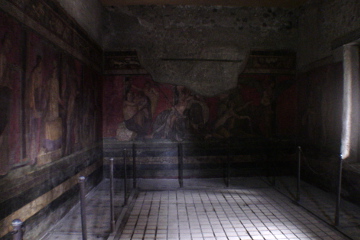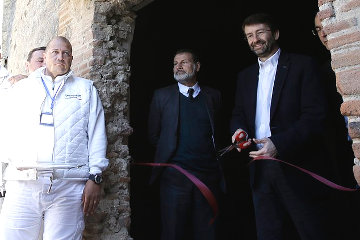Mysteries Revealed
It took Mussolini to make Italian trains run on time and now it seems that has taken similar strong-arm tactics from the European Union to make Italy's antiquities department run on time.
Over the past few years a series of horror stories have come out of Pompeii, the amazingly preserved Roman city that was overwhelmed by the eruption of Vesuvius in AD 79. Heavy rain has brought down walls and even an entire villa, the Villa of the Gladiator, while other buildings have had to be closed to the public for fear of harm to either the public or the building. Loudly trumpeted restoration projects have foundered, either on southern Italy's endemic corruption and crimnal gangs - nearby Naples is home to its own vicious version of the Mafia - or on indolent bureaucrats who used innumerable rules and regulations as an excuse for doing nothing.

| |
| The unrestored room pictured in 2007 and heavily "tweaked" in Photoshop to make the frescoes visible in the gloom! |
One of the big disappointments of the 2007 Diggings tour of Greece and Italy was when I searched for the Villa of the Mysteries and found that it was closed. You could wander in - there were no guards that I could see - but the room with the famous frescoes was closed by a barrier of wood and steel. I managed to insert my camera through a gap and clicked the button without much hope and the result justified my pessimism.
In 2011 the EU offered the Italians £78 million towards the restoration of Pompeii. The Italians, naturally, leaped on the money with both hands and then, equally naturally, did nothing with it (apart, one presumes, from hiring another layer of bureaucrats whose remit was to find ever more ingenious excuses for delay).
I am delighted to report that the EU has finally forced the Italians to act. Not only did it threaten to withdraw the promised funding by December 31, 2015 - which meant that Italy would have to repay the sums already spent on the aforesaid bureaucrats - but it also persuaded UNESCO to threaten to take Pompeii of the list of World Heritage sites. I'm not sure which was the more persuasive of the two threats: financial loss that Italy could ill afford or the national disgrace of losing World Heritage status for one of its premiere sites.
Suddenly the petty rules ceased to apply, official obfuscation ceased, regiments of bureaucrats actually had to do something to justify their salaries, and workmen were not only hired but expected to do more than brew tea and smoke cigarettes. Eighty-five new employees have been taken on both to carry out work and to ensure that buildings are no longer shut "for lack of staff". Sixteen restoration projects have been initiated, of which three are now complete and the remainder are actually underway. Contracts worth sixty-five million euros have been signed and if anyone is wondering where the remaining forty million euros will go or have gone, no doubt Italian bureaucrats are even now dreaming up new forms of creative accounting to explain it all to the EU's satisfaction.

| |
| Italy's minister for culture cuts the ribbon to open the restored Villa of the Mysteries. |
To emphasise the point, culture minister Dario Franceschini held a ceremony to mark the reopening of the Villa of the Mysteries. A purple ribbon was cut and some of the forty million went on a slap-up lunch with lots of nibbles and even more vino (Dario could, with advantage, have spent a bit more on a tie and a shave, but one mustn't expect miracles) and pictures were released showing tourists wandering around the room and admiring the restored frescoes.
Unfortunately, the 65 million euros and the 85 additional employees seem not to have included someone with responsibility for ensuring that tourists do not use flash lighting for their pictures. If you look at the accompanying photograph, you will see that behind the lady in red on the left is a circular burst of light from someone else firing off his or her camera flash.
I realise that few tourists know how to turn the flash off on their cameras and, such is the confusing nature of camera menu systems, even when you think you have, you may very well just have switched between red-eye reduction mode and some other mode. The solution is, however, extremely simple: as tourists enter the room they must show their cameras and the attendant then simply places a bit of black tape over the flash.

| |
| Tourists flock into the restored Villa of the Mysteries and promptly set about degrading its priceless frescoes. |
Actually, a bit of black tape - or a hammer and chisel - could be applied to every built-in flash. I have a big, semi-professional flash and when used on its highest setting it will adequately illuminate people or objects up to twenty feet away (twenty-four with a following wind). The tiny little flash on a digital compact camera will manage eight feet - yet you see imbecilic individuals firing off their flashes at the Great Pyramids or Andre Rieu on stage from several hundred feet away. No doubt they are bitterly disappointed when they get home and find a perfectly black picture, whereas if they had turned the flash off, the sensitivity of modern digital cameras is such that they might well have had a reasonable picture.
I am delighted that the Villa of the Mysteries is now open. I do wish, however, that the authorities had spent another couple of thousand euros and placed perspex over every single one of the frescoes. Inevitably you will have some moron who can only properly "see" the paintings by running his or her hands over them, or some sweating oik who will lean back against one wall in order to fit in more of the opposite wall, or even the accidental damage when someone with a selfie-stick bumps it against the priceless plaster and gouges a big hole in it.
I know that perspex (or glass) will ruin the appearance of the room, but I would rather suffer the minor loss and know that my great-grandchildren will be able to enjoy the beauty of the paintings rather than be confronted with a battered, faded expanse of near-white plaster and a sign saying "This used to be decorated with wonderful frescoes."
Villa of the Mysteries So called from the frescoes which cover three walls of an inner room and which appear to depict scenes from the Mystery of Dionysus. Certainly a fat male figure who appears to have all the attributes of Dionysus appears in one of the panels, but all the other figures are female, which would be unusual for the cult of Dionysus, which was usually male. I think it more likely that the "mystery" is the women's god or women's festival. On the other hand the information we have about the official women's mystery, the Bona Dea, does not match the scenes in the Villa of the Mysteries.
One scene that always attracts attention is where a naked young woman - presumably the same naked young woman shown in other panels - is whipped by a female figure. This rather negates the suggestion advanced by Paul Veyne that the panels in fact depict a marriage ceremony. On the other hand Plutarch, in his essay On God's Slowness to Punish, tells us that "In Rome the process of emancipating a slave involves striking him on the body with a light stalk." Although emancipation did not involve naked dancing, it is not impossible that some such ceremony might be included in a "mystery" to indicate that the initiate was no longer a slave to his or her former life. Return
flash lighting I am assured by museum curators to whom I have spoken that the short but intense light from a flashgun can produce the same fading effect as exposure to bright sunlight. I do not know whether any tests have been done to prove this claim but I am willing to give them the benefit of the doubt. I would not wish to contribute to the deterioration of our ancient heritage when I am perfectly capable of using a camera without flash.
I admit, however, to being annoyed when flash photography is forbidden in - for example - the Great Pyramid. There are no paintings whose colours can be degraded, only stone which sat outside in the bright sunshine for thousands of years without any deleterious results. Return
© Kendall K. Down 2015





